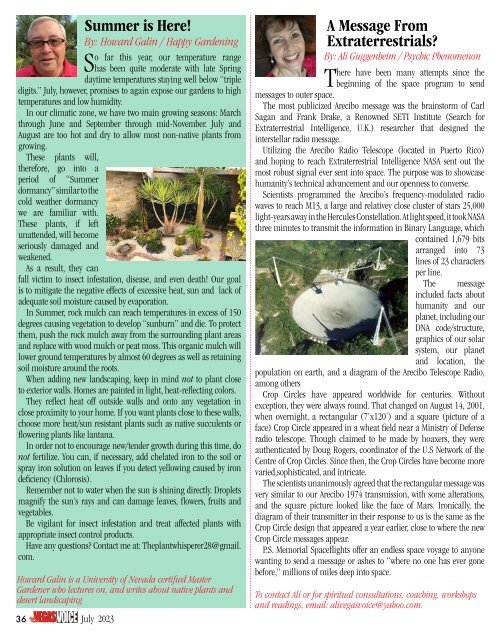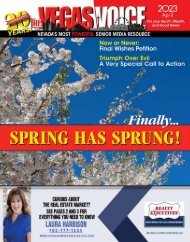Create successful ePaper yourself
Turn your PDF publications into a flip-book with our unique Google optimized e-Paper software.
By: Howard Galin / Happy Gardening<br />
So far this year, our temperature range<br />
has been quite moderate with late Spring<br />
daytime temperatures staying well below “triple<br />
digits.” <strong>July</strong>, however, promises to again expose our gardens to high<br />
temperatures and low humidity.<br />
In our climatic zone, we have two main growing seasons: March<br />
through June and September through mid-November. <strong>July</strong> and<br />
August are too hot and dry to allow most non-native plants from<br />
growing.<br />
These plants will,<br />
therefore, go into a<br />
period of “Summer<br />
dormancy” similar to the<br />
cold weather dormancy<br />
we are familiar with.<br />
These plants, if left<br />
unattended, will become<br />
seriously damaged and<br />
weakened.<br />
As a result, they can<br />
fall victim to insect infestation, disease, and even death! Our goal<br />
is to mitigate the negative effects of excessive heat, sun and lack of<br />
adequate soil moisture caused by evaporation.<br />
In Summer, rock mulch can reach temperatures in excess of 150<br />
degrees causing vegetation to develop “sunburn” and die. To protect<br />
them, push the rock mulch away from the surrounding plant areas<br />
and replace with wood mulch or peat moss. This organic mulch will<br />
lower ground temperatures by almost 60 degrees as well as retaining<br />
soil moisture around the roots.<br />
When adding new landscaping, keep in mind not to plant close<br />
to exterior walls. Homes are painted in light, heat-reflecting colors.<br />
They reflect heat off outside walls and onto any vegetation in<br />
close proximity to your home. If you want plants close to these walls,<br />
choose more heat/sun resistant plants such as native succulents or<br />
flowering plants like lantana.<br />
In order not to encourage new/tender growth during this time, do<br />
not fertilize. You can, if necessary, add chelated iron to the soil or<br />
spray iron solution on leaves if you detect yellowing caused by iron<br />
deficiency (Chlorosis).<br />
Remember not to water when the sun is shining directly. Droplets<br />
magnify the sun’s rays and can damage leaves, flowers, fruits and<br />
vegetables.<br />
Be vigilant for insect infestation and treat affected plants with<br />
appropriate insect control products.<br />
Have any questions? Contact me at: Theplantwhisperer28@gmail.<br />
com.<br />
36<br />
Summer is Here!<br />
Howard Galin is a University of Nevada certified Master<br />
Gardener who lectures on, and writes about native plants and<br />
desert landscaping<br />
<strong>July</strong> <strong>2023</strong><br />
A Message From<br />
Extraterrestrials?<br />
By: Ali Guggenheim / Psychic Phenomenon<br />
There have been many attempts since the<br />
beginning of the space program to send<br />
messages to outer space.<br />
The most publicized Arecibo message was the brainstorm of Carl<br />
Sagan and Frank Drake, a Renowned SETI Institute (Search for<br />
Extraterrestrial Intelligence, U.K.) researcher that designed the<br />
interstellar radio message.<br />
Utilizing the Arecibo Radio Telescope (located in Puerto Rico)<br />
and hoping to reach Extraterrestrial Intelligence NASA sent out the<br />
most robust signal ever sent into space. The purpose was to showcase<br />
humanity’s technical advancement and our openness to converse.<br />
Scientists programmed the Arecibo’s frequency-modulated radio<br />
waves to reach M13, a large and relativey close cluster of stars 25,000<br />
light-years away in the Hercules Constellation. At light speed, it took NASA<br />
three minutes to transmit the information in Binary Language, which<br />
contained 1,679 bits<br />
arranged into 73<br />
lines of 23 characters<br />
per line.<br />
The message<br />
included facts about<br />
humanity and our<br />
planet, including our<br />
DNA code/structure,<br />
graphics of our solar<br />
system, our planet<br />
and location, the<br />
population on earth, and a diagram of the Arecibo Telescope Radio,<br />
among others<br />
Crop Circles have appeared worldwide for centuries. Without<br />
exception, they were always round. That changed on August 14, 2001,<br />
when overnight, a rectangular (7’x120’) and a square (picture of a<br />
face) Crop Circle appeared in a wheat field near a Ministry of Defense<br />
radio telescope. Though claimed to be made by hoaxers, they were<br />
authenticated by Doug Rogers, coordinator of the U.S Network of the<br />
Centre of Crop Circles. Since then, the Crop Circles have become more<br />
varied,sophisticated, and intricate.<br />
The scientists unanimously agreed that the rectangular message was<br />
very similar to our Arecibo 1974 transmission, with some alterations,<br />
and the square picture looked like the face of Mars. Ironically, the<br />
diagram of their transmitter in their response to us is the same as the<br />
Crop Circle design that appeared a year earlier, close to where the new<br />
Crop Circle messages appear.<br />
P.S. Memorial Spaceflights offer an endless space voyage to anyone<br />
wanting to send a message or ashes to “where no one has ever gone<br />
before,” millions of miles deep into space.<br />
To contact Ali or for spiritual consultations, coaching, workshops<br />
and readings, email: alivegasvoice@yahoo.com.
















